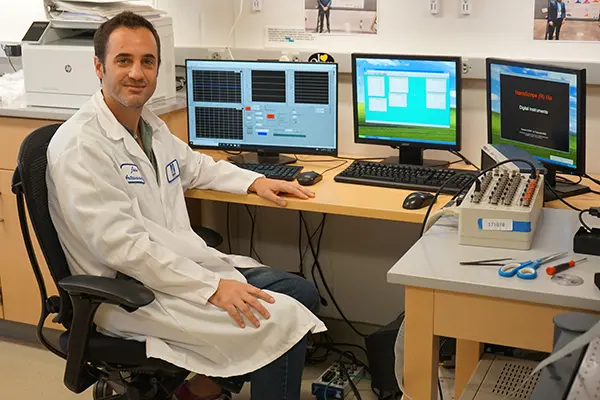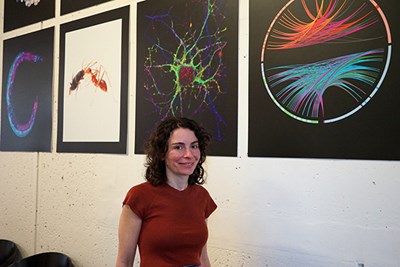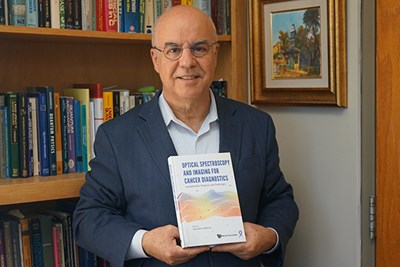Chemistry Lab Group Targets RNA Associated With Cancer, COVID-19
 Image by Courtesy
Image by Courtesy
10/13/2023
By Brooke Coupal
Early detection of cancer can mean the difference between life and death.
According to the World Health Organization, cancer outcomes improve when treatments are provided at the earliest possible stage. “When cancer care is delayed or inaccessible, there is a lower chance of survival,” the organization says.
Chemistry Asst. Prof. Juan Artes Vivancos and his research team’s recent findings, published in the Nature Portfolio journal Scientific Reports, may pave the way for early cancer detection.
“If you can detect cancer early on, you can save lives,” Artes Vivancos says.
Targeting RNA to Detect Cancer
What if a device could detect a single molecule associated with cancer, alerting a person early on that the disease may be present? That is the question Artes Vivancos and his team had in mind as they conducted their research, which was funded in part by a $300,000 National Science Foundation grant.
RNA (ribonucleic acid) is a molecule found in human cells, including those that are cancerous. Previous research has shown that RNA has different sequences, depending on the form of cancer that exists. With this information, the research group sought a way to target RNA found in some of the most elusive and deadliest forms of cancer, such as pancreatic, which, according to the National Cancer Institute, has led to more than 50,000 deaths in the United States so far this year.
The team designed a probe, which is a strand of DNA that is complementary with the target RNA. When a sample of the RNA comes in contact with the probe, it binds to the DNA to form a double helix.
 Image by Brooke Coupal
Image by Brooke Coupal
Under a scanning tunneling microscope, which can be used for imaging surfaces at the atomic level, an electrical voltage is applied to the probe. If the target RNA is present and has formed a double helix with the probe’s DNA, then an electrical signal happens. If the target RNA is not present to form the double helix, then no signal is emitted. The detection of the target RNA could indicate cancer.
“That was a significant finding that we were able to detect the single molecule using this technique,” says Keshani Gunasinghe Pattiya Arachchillage ’23, a recent UML alum whose chemistry Ph.D. dissertation focused on this research.
Artes Vivancos says the presence of the RNA sequences is like a “red flag” that could prompt additional tests for early-stage cancers.
The researchers hope their findings will aid in the development of a small, noninvasive device that uses their technique to detect RNA found in cancer cells through blood, saliva and other samples.
“That’s the future goal,” Arachchillage says. “This is just the beginning.”
From Cancer to COVID-19
With the cancer detection project underway, Artes Vivancos and his team wanted to expand their research to include infectious disease detection.
“Then in 2020, COVID-19 happened,” says Arachchillage, who joined Artes Vivancos’ lab two years before the pandemic started.
Using the same technique, the research group looked to detect COVID-19 by targeting RNA associated with different variants of the virus. Each variant has a different RNA sequence, just as different forms of cancer do. The researchers designed DNA probes that give off an electrical signal when a specific variant’s RNA is found. Their vision is to have one device that has different signals for each target RNA, showing which variant may be present.
 Image by Courtesy
Image by Courtesy
Their findings, published in the scientific journal Biosensors and Bioelectronics, could be used for early detection of COVID-19.
“The advantage that we have with this approach is that if a single target RNA molecule is around, we have a high probability of detecting it,” Artes Vivancos says.
After five years of working on these projects, Arachchillage is proud that the findings are now available to the public.
“I’m really happy we were able to get these results,” she says. “My goal is to help the health sector. That’s my motivation to do research.”
Along with Arachchillage, Artes Vivancos’ research team consisted of graduates, undergraduates and even local high school students who had found his lab online and reached out to help with the work.
Whether conducting experiments, analyzing data or helping write the papers, Artes Vivancos says, “Every student found their place within the team.”
Patrick Piscitelli ’23 is one of those students. The honors chemistry alum joined the research group during his senior year and quickly got involved with the experiments. He is now a co-author of both papers and a biophysical chemistry Ph.D. student at Yale University.
“I cannot overstate how valuable it was to be able to get research experience as an undergraduate,” he says. “What I learned about academic research and how it actually works from being a part of (Artes Vivancos’) lab has already proven to be so useful to me.”


